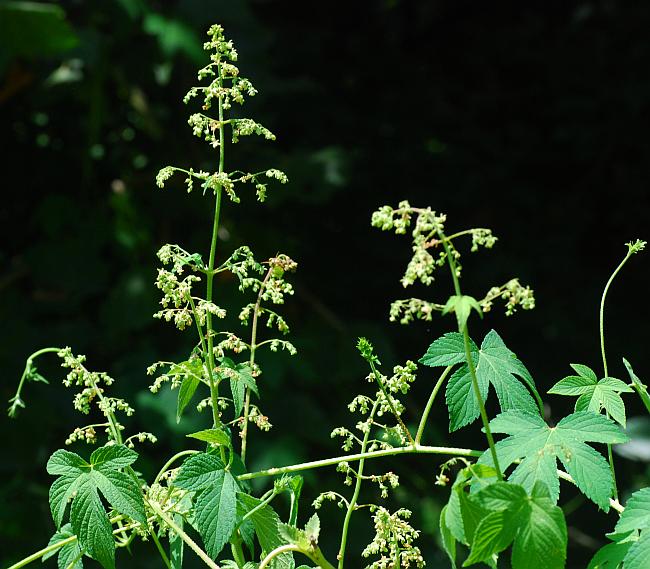Humulus japonicus Siebold & Zucc.
Japanese Hops

Introduced
CC = *
CW = 3
MOC = 26
© SRTurner
Humulus japonicus Siebold & Zucc.Japanese Hops | |
 |
Introduced CC = * CW = 3 MOC = 26 |
© SRTurner |
|
Family - Cannabaceae Habit - Dioecious taprooted annual. Stem - Twining, branched, to 5 m or more long, with small but stiff, spiny hairs along the ridges.
Leaves - Opposite but sometimes alternate near stem tips, petiolate, with petioles armed with stiff, spiny hairs. Blades to 15 cm, broadly ovate in outline, with 3-9 deep palmate lobes, roughened with stiff, bulbous-based hairs, the undersides with yellowish sessile glands.
Inflorescence - Staminate panicles to 30 cm long, 2-4 cm wide. Pistillate spikes 1-2 cm long at flowering, elongating to 3.0 cm long at fruiting, the bracts 7-12 mm long, ovate to broadly ovate, hairy, not glandular.
Flowers - Staminate flowers 1.5-3.0 mm long, the 5 free sepals lanceolate to ovate, hairy. Petals absent. Stamens 5. Pistillate flowers with single pistil, superior ovary with 2 fused carpels, style 1, stigmas 2, ovule 1.
Fruits - 3-4 mm long, 2.5-4.0 mm wide, the surface smooth, light brown to yellowish brown, enveloped in persistent bracts which form a conelike structure.
Flowering - July - October. Habitat - Riverbanks, bottomland prairies, moist disturbed areas. Origin - Native to Asia. Lookalikes - None close. Other info. - This species is an invasive pest along riverbanks, forming large monospecific mats which choke out other vegetation. The hooked, spiny hairs on the stems will draw blood from bare legs of anyone foolish enough to walk through it. It should be eradicated wherever possible. Fortunately, it usually becomes overwhelmingly dense only late in the season, after many other plants have had a chance to flower. Photographs taken at Washington Riverfront Park, Franklin County, MO, 8-23-2014, 9-27-2018, and 9-11-2024 (SRTurner). |